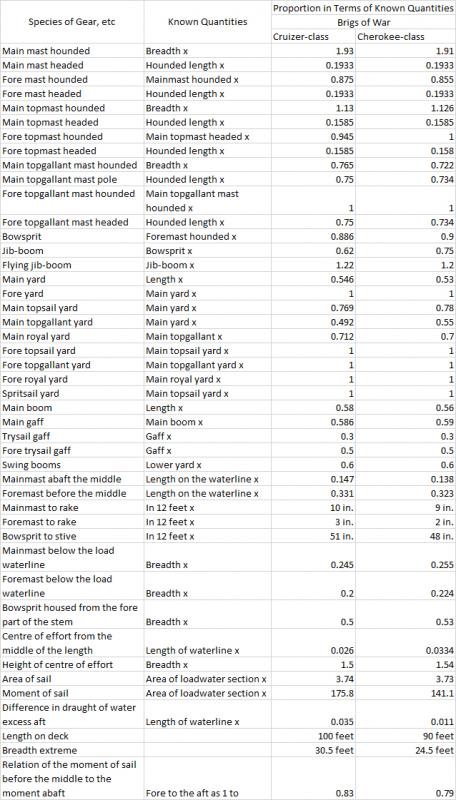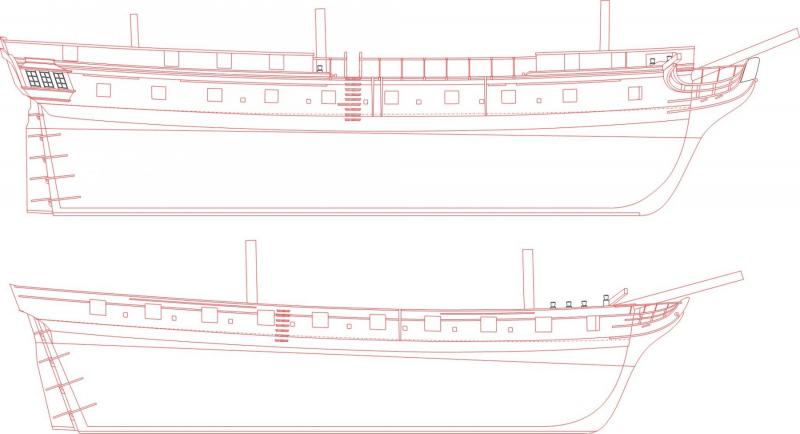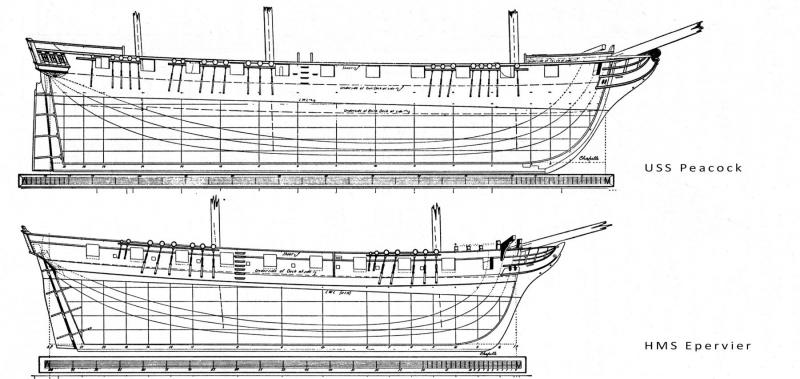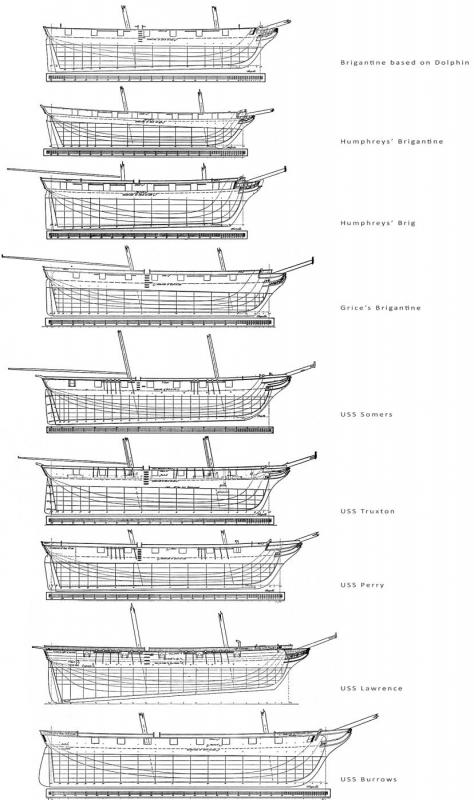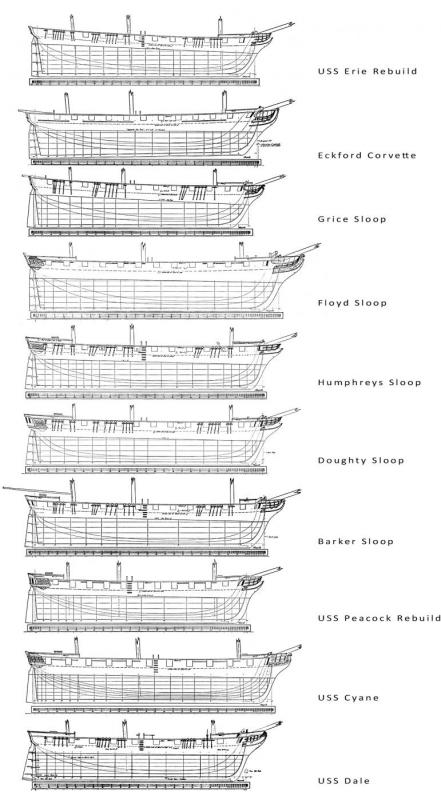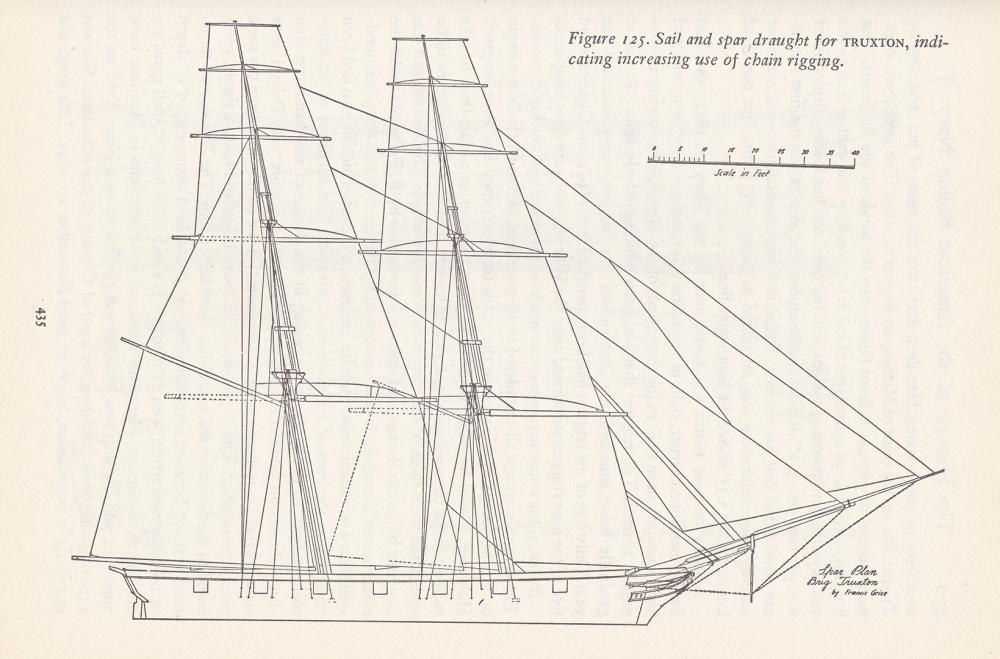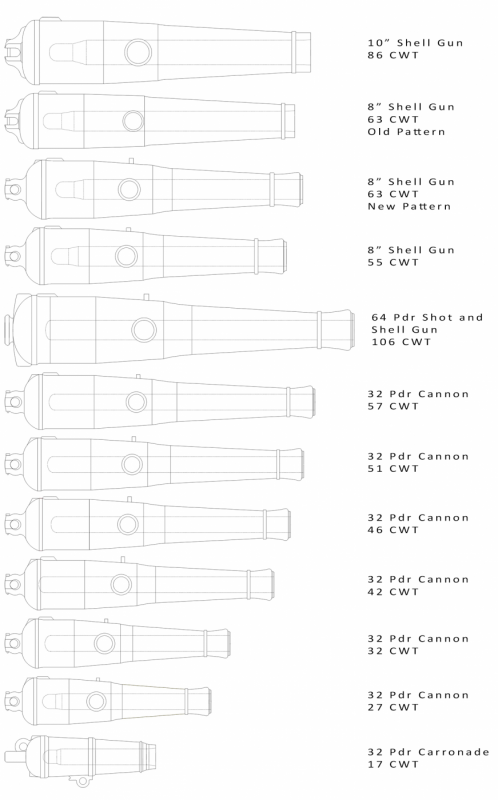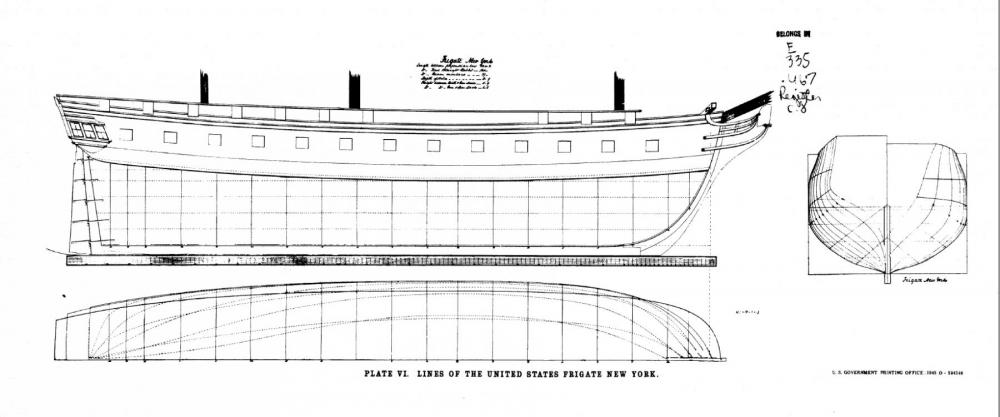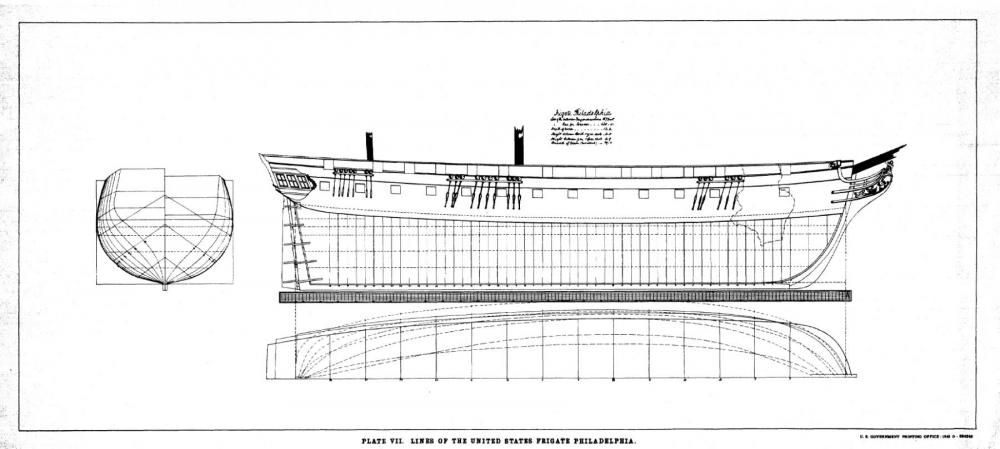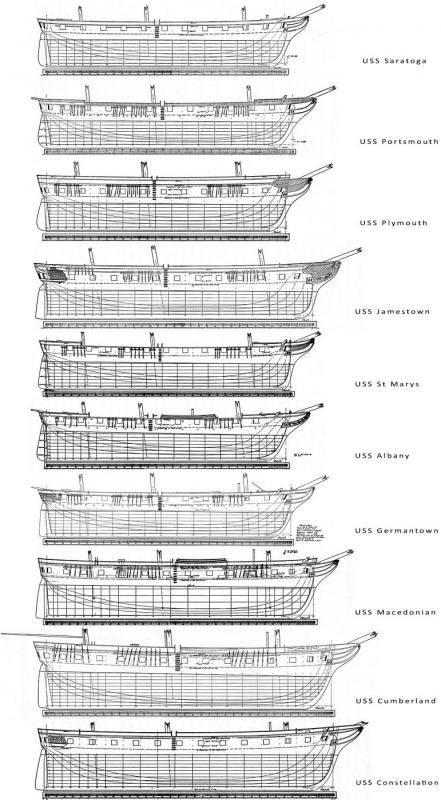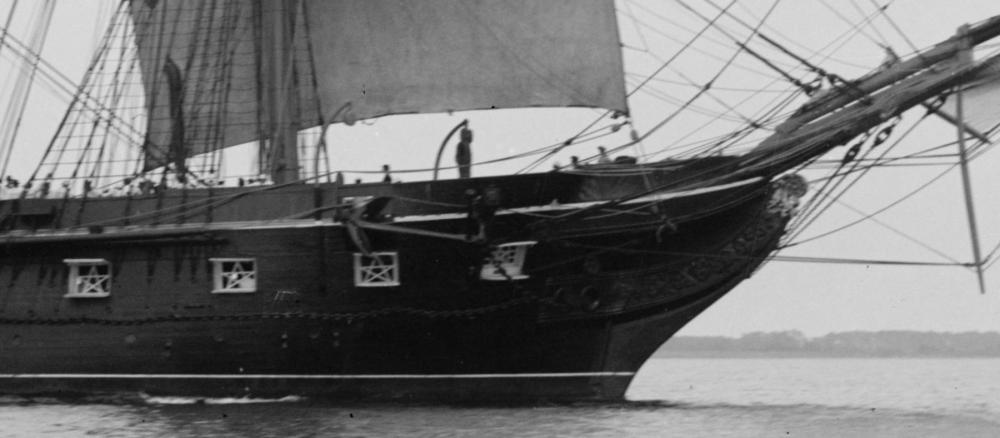
Talos
Members-
Posts
413 -
Joined
-
Last visited
Content Type
Profiles
Forums
Gallery
Events
Everything posted by Talos
-
Cruizer-class Brig-Sloops of the Royal Navy
Talos replied to molasses's topic in Nautical/Naval History
Totally meant to post this earlier with the discussion about sparing. I found this table in a 19th century book on rigging (I have to go back and look it up again to see which one. I realized that the measurements listed for hull length were that of the Cruizer and Cherokee. -
Lost voices from HMS Guerriere: Court Martial testimony.
Talos replied to uss frolick's topic in Nautical/Naval History
The British still had no qualms about fighting in the Lee gauge. Heck, often they even did it to cut off a fleeing French ship. There were plenty of times when it was more advantageous than the weather gauge. -
Lost voices from HMS Guerriere: Court Martial testimony.
Talos replied to uss frolick's topic in Nautical/Naval History
While British doctrinw preferred the weather gauge, the lee gauge had advantages too, particularly that you could slip away and break off the engagement a lot easier. That might have been in his mind engaging a heavier opponent. -
Very interesting stuff. I've always been fascinated by Epervier as the USN's short-lived example of a Cruizer-class brig. A shame she was lost so soon after, though after getting some American modifications (enlarged gunports, headrails, and increase rake of her masts). I did notice the mention of the captain on the quarterdeck and the tiller on the deck, which would imply to me it was not one of the Cruizers with the aft platform. In those there was very little headroom, the main boom passes over the platform, and the tiller is mounted on top (above the bulwarks) in a lot of them too. This makes me want to finish my drawing of her from Chappelle, and do the American modifications too. I also have a vague idea of doing the ship rig too, and a modified exploration vessel in the same vein as HMS Beagle's modifications to the smaller Cherokee-class. (the other ship in the drawing is Chappelle's take on Cyane, but it's incorrect. He was sent the Bittern-class Cyane plans instead of the Brazen-class and he dressed it up with War of 1812-style bulwarks and such. Hmm, if you continue doing these after-action reports...) EDIT: Threw together a quick size comp of Peacock and Epervier. They're alligned at the aft perpendicular to show the length difference better.
-
American sailing warships with no plans or records
Talos replied to CharlieZardoz's topic in Nautical/Naval History
You can see the typical American obsession with speed in these ships too, especially with the shallowness of their hulls and the massive sail plans (seriously, Truxton's is scary-huge). With Lawrence it was the extreme V-shape of her hull. She was the most extreme clipper (as in Baltimore clipper) design ship the US Navy ever built. It was a combination of the stern being way deeper than any other brig (at least as deep as a large sloop of war), and an inability to wedge enough supples in the hull for an overseas deployment that caused the ship to be retired after just a few years. With the other brigs, it was just a general comment on their shallow, sharp hulls and big rigs, especially compared to the previous, deeper USS Dolphin. Cyane had increased length and tonnage that allowed the designer to give her much finer and better lines than the very blunt Bostons. There's a second set of finer hull lines on her plans, it's possible that at the last minute Humphey decided to push a little harder for more speed. She (and Levant) were both faster and better sailors and able to carry their armament even better than the sloops of the 1820s. It's certainly a matter of balance between effectiveness and costs, along with quality versus quantity. If you cheapen out on the ship enough, does it matter if it's not going to stand up to an enemy warship in action? The Navy at the time was also adopting a "peacetime armament" idea, where a ship lands a couple guns in peacetime, usually the chasers. @frolick: Philadelphia carried sixteen 32-pounder carronades as her upper-deck armament in 1803. Before that she carried 9-pounders in her upper works. I had noticed that carronade in back too! The 9-pounder is probably a chase gun.- 401 replies
-
- John Adams
- Alliance
-
(and 3 more)
Tagged with:
-
American sailing warships with no plans or records
Talos replied to CharlieZardoz's topic in Nautical/Naval History
Thanks, Charlie. I did them for myself originally since I love the side by side comparisons. You can really see things like changes in lines, sizes, detail, etc. Erie was a rebuild of the War of 1812-era sloop and man, she does have a ton of drag. Ended up as a store ship late in life. The next three, designs by Eckford, Grice, and Floyd, were never built, but were proposals that helped shape the Boston class. Eckford's was the original design that started it all, while Grice's was smaller and cheaper. Floyd's was quite a bit bigger, but featured a couple extra guns. The Bostons were never amazing, they were pretty slow due to their hull forms and overloaded. A big part of this was the Navy cheapening out and sticking the Floyd's armament in a hull quite a bit smaller. I’m pretty sure all three were used. Humpreys’ was the main design of course, but Doughty’s was used for the Warren, Natchez, and Lexington. Chapelle notes that Boston and Vincennes were both listed as having a beam slightly narrower than the others, which matches the dimensions of the Barker design, so they might have been that. Chapelle does note that while none of the hulls are really that good (to blunt for good speed), Barker’s stern lines were slightly better than the others. The Bostons and the later 3rd-class sloops of the Dales were a good showcase for the problems with going cheap when building ships. Dales were tiny, built roughly in the dimension of the War of 1812 original sloop Peacock, but loaded with heavier guns, more boats, more supplies, etc. Chapelle noted that while they were great sailors, and good cheap ships to show the US flag in foreign ports, they were very lightly armed and outmatched even by some European brigs of the era. Better in peacetime than in war. They were originally armed with custom, short 24-pounders that were a unique design. These were pretty conical, with trunnions mounted well below the centerline of the gun. Thomas ap Catesby Jones, uncle of the future CSS Virginia commander from the Battle of Hampton Roads, Catesby ap Roger Jones, was serving as ordnance inspector and he denounced the guns heavily. They were too light and short, weren’t safe to use heavy charges or double-shot. They were all refitted with 32-pounder carronades instead. Two survived the Civil War, and the class ship survived until 1906. We have a couple photos of her. Dale herself was a sail training ship for a long time, which was a role she was well-suited for, being smaller and cheaper to operate but still maintaining a full three-masted ship rig. You can see the difference with Cyane, which was a much more successful design, fast, good sailor, and carried her armament well. That extra tonnage made all the difference. It was an enhancement on the rebuilt Peacock, which was a very sharp design and too overloaded with her as-built armament. After Cyane, Saratoga was even bigger and a very successful design, so it set the pattern for the 1840s big sloops we were talking about earlier, all of which were successful (except for poor Albany). Speaking of brigs earlier, the Navy had a string of very extreme brig designs in the end. Somers, Bainbridge, Lawrence, Truxton, and Perry were all crazy designs. Lawrence was the big failure, being an extreme clipper shape with an incredible drag to her keel. Her hull was too cramped for enough supplies and she drew a huge amount of water aft. Only lasted a few years before she was sold. Somers was the site of the Somers Affair, the only mutiny in US Navy history, which resulted in the son of the Secretary of War (a midshipman) and two others being hung from the yardarms of the brig. This is what led to the abolishing of the midshipmen training and the founding of the US Naval Academy. She later capsized suddenly a few years later. Her sister, Bainbridge, also capsized later during the Civil War. Truxton was a different design that had to be fitted with lighter carronades than the others. She grounded and was burned during the Mexican-American War. The final one was Perry, which was very active in anti-slavery patrols in Africa, where she could sail in shallower waters. She had a counter stern with a large cabin aft on the gundeck, which meant she couldn’t use stern chasers. Perry lasted through the Civil War and was sold off at the end of it. The unusual brig I wanted to highlight, especially after the Dales, was a never-built brig that was to be named Burrows. She’s unique and much larger than the others, being 126 feet long, nearly ten feet longer than Dale was. Just looking at her hull lines and sail plan, she probably would have been a hell of a sailor. Pierced for sixteen guns, plus chasers, which is 2-4 more than the smaller brigs. Overall just a fascinating what-if ship. You can see her at the bottom of the brig comparison I’m attaching.- 401 replies
-
- John Adams
- Alliance
-
(and 3 more)
Tagged with:
-
American sailing warships with no plans or records
Talos replied to CharlieZardoz's topic in Nautical/Naval History
In my random trawling of the NH&HC site today, I found this beautiful shot of the USS St Louis, the last surviving member of the Boston-class sloops from the 1820s. She was a sistership of both the rebuilt USS John Adams and the famous globetrotting USS Vincennes. There were three designs used for that class, ones by Humphreys, Doughty, and Barker. I might be seeing things, but she reminds me more of the Barker plan than the others. You can see the three designs marked as such in the attachment. Another thing is the number of gunports on the side (filled in with windows). The original ship had a dozen plus bridle ports per side. This has eight, plus bridles. I wonder when she got refitted, because her Civil War armament was 18 guns (4 x 8" shell guns, 12 x 32-pounders and 2 x 20-pounder Parrotts), which would fit that port arrangement exactly. Also a gorgeous picture of St. Mary's. Such a handsome vessel.- 401 replies
-
- John Adams
- Alliance
-
(and 3 more)
Tagged with:
-
American sailing warships with no plans or records
Talos replied to CharlieZardoz's topic in Nautical/Naval History
Many ships had the stripe removed during the war to help hide on blockade. With the all-black hull it was much harder to spot the ships in low light. This included ships like Farragut's squadron of sloops and gunboats pulled from the blockade and sent up the Mississippi. They did this back during the War of 1812 as well. I think President had her stripe painted out when she was trying to slip out to see past the British blockade. This wasn't universal though, you can see pictures of Santee and Constitution on training duty at the Naval Academy still having their stripes, so when you get to the 1870s it wasn't that the stripe was brought back, more that they weren't involved in war at the time. You see the short-lived ships built at the end of the war like Congress using it. Macedonian doesn't seem to get her stripe back during the war after her time on the blockade, as seen in photographs, while most of the photos of Pensacola from the war I've seen show her with a stripe. It's possible she kept hers since she wasn't operating close in-shore like other ships. Then sometime by the 1880s they had switched navy-wide to an all-black scheme with a narrow white stripe along the upper hull and a narrow one on the divide between hull and copper. The only exception was Constitution, which I've seen in pictures in the 1880s and 1890s with the stripe still in place, but she was already a heritage ship by that point.- 401 replies
-
- John Adams
- Alliance
-
(and 3 more)
Tagged with:
-
American sailing warships with no plans or records
Talos replied to CharlieZardoz's topic in Nautical/Naval History
Speaking of Albany's old guns, here's something related. These are the frigate Philadelphia's old cannons recovered in Tripoli.- 401 replies
-
- John Adams
- Alliance
-
(and 3 more)
Tagged with:
-
American sailing warships with no plans or records
Talos replied to CharlieZardoz's topic in Nautical/Naval History
Much weaker design. Dahlgren approached his gun designs scientifically and really changed how he designed them compared to earlier guns. With the Peacemaker gun on Princeton, the gun itself was an experimental material plus the design wasn't strong enough. A second of the design survives at the Naval Academy. That gun, and Dahlgren's, are detailed in Spencer Tucker's Arming the Fleet (which is also where I found the table of dimensions to do the drawings of the 1840s cannons).- 401 replies
-
- John Adams
- Alliance
-
(and 3 more)
Tagged with:
-
American sailing warships with no plans or records
Talos replied to CharlieZardoz's topic in Nautical/Naval History
It was the standard frigate armament. She probably would have been overloaded with a gundeck of IX-inch Dahlgrens and a second gundeck of 32-pounders. Since she had the spar deck still, she wouldn't get the heavier guns like Cumberland. She also had twice as many guns, so her weight of iron wasn't any lower. It's pretty common to arm razees with a heavier gun since they suddenly don't have the weight of an upper deck and the guns from that deck on top of everything.The 32-pounder did have advantages in faster firing (faster to load and the 32-pounder shot is the biggest that one man can easily carry. It takes two men with a sling or clamp to carry a IX-inch shell). I definitely think they influenced Dahlgren when he started experimenting. He didn't do his guns until over a decade after these were designed though. It was a general push towards simplier guns, with a different distribution of iron (more of it over the breech, less on the barrel). The bottle shape only really goes for the true Dahlgrens, which have no angles at all on them, unlike these. They definitely reduced the weakpoints though, and these are pretty darn good cannons. As far as Buggs, it's simple. Cheaper to draw and animate without any details on it!- 401 replies
-
- John Adams
- Alliance
-
(and 3 more)
Tagged with:
-
American sailing warships with no plans or records
Talos replied to CharlieZardoz's topic in Nautical/Naval History
As one of the replacement guns, yes, not one of the original Paixhan-style 10" guns. And they probably were about as good as it was going to get. Monitor had a pair of XI-inch Dahlgrens firing reduced charges and did pleny of damage to Virginia (just not any disabling ones). Cumberland had a heavy rifle that was probably also potentially damaging to it, plus a full battery of twenty-two IX-inch Dahlgrens that at close range were much more damaging than Congress' 32-pounders. This is a 50-pounder Dahlgren rifle. Her second pivot was likely either this or a bigger version. Completely smooth and with an interesting trunnion band wrapped around it the cascable at the back of the gun. Oh, it got worse later on! The irony is the brig Truxton was the one with the craziest depicted sail plan. I'm attaching her's and coupled with a shallow, v-shaped hull... and yet she's the one that didn't get lost at sea! (she was wrecked on rocks in the Mexican-American War). I'm also linking Albany's ship rig. Chapelle includes the original bark rig too, with the fore-and-aft mizzen. She has an extreme v-shaped hull too. Dahlgrens can't be on Albany, she was lost before they were introduced. In fact, she was lost shortly after the book I was quoting from was written. She had 8" shell guns of 63 cwt and 32-pounders of 42 cwt. It's always possible they were misidentified (since they were advanced, undecorated guns) and was Albany. She was leaving Colombia when she was lost. Does sound like an interesting site to check out though!- 401 replies
-
- John Adams
- Alliance
-
(and 3 more)
Tagged with:
-
American sailing warships with no plans or records
Talos replied to CharlieZardoz's topic in Nautical/Naval History
They had been replaced by then. The early 10" shell guns were very lightweight for their size and were quickly replaced because they were structurally weak and couldn't stand up to a strong enough charge. That was one of the big pushes for the X-inch Dahlgrens. The British had a 10" of 84 cwt and similar problems. The 64-pounder shot guns that could fire both solid shot and shells, was the more effective battering gun until the big Dahlgrens came around. When Dahlgren wrote his "Shells and Shell Guns" in 1856, which was a manual on the gun system of the USN then, the 10" of 86 cwt was already on the way out. He even marked out the range table for it with the following footnote: "The practice of this gun was discontinued by the Chief of Bureau, who decided not to use it any longer on U.S. ships. A new and heavier X-inch (ed: note the Dahlgren-style roman numeral) has since been introduced." By the time she was sunk, Cumberland had a big Dahlgren smoothbore shell gun and most likely a 60-pounder Dahlgren rifle. We were discussing it over at Civil War Talk and I found mention of Dahlgren prescribing that armament at the start of the war for pivots, with the erroneous references to a "50-pound rifle" being a typo.- 401 replies
-
- John Adams
- Alliance
-
(and 3 more)
Tagged with:
-
American sailing warships with no plans or records
Talos replied to CharlieZardoz's topic in Nautical/Naval History
The sloop was definitely centered as the main unit in those days. Even some of the frigates were stripped of their upper-deck armaments and treated like a sloop because sloops were so much cheaper. I'm pretty sure Constitution was at that time. Coupled with a rise in the main deck armament from 24-pounder cannons and such to the new standardized 32-pounders seen above in the 1840s, they were powerful little buggers and really the perfect balance as cruisers. The armaments established in 1845 (modified in 1853) were, for sloops, as follows: 1st class (which should include all the ships on that comparison page): 32-pounders of 42 cwt and 8" shell guns of 63 cwt. 2nd class (Boston, Cyane, etc): 32-pounders of 32 cwt and 8" shell guns of 55 cwt. 3rd class (should just be the Dales): 32-pounders of 27 cwt, replacing the light 24-pounder short guns that were designed for the class but didn't work that well. Macedonian, Cumberland, and Constellation each carried those weak 10" shell guns fore and aft as pivots. 1 cwt also equals 112 pounds, fyi. Also I did those drawings the old-fashioned way, took the tabulated dimensional numbers for each gun (down to the hundredth of an inch) and drew them from that, so they should be about as accurate as it gets. The frigates, meanwhile, were armed with 32-pounders of 57 cwt on the main deck, plus 4 x 8" shell guns of 63 cwt. On the spar deck they had 32-pounders of 32 cwt plus 4 x 8" shell guns of 55 cwt and two 32-pounders of 51 cwt for chase guns. Some of the biggest had 42cwt guns up top and smaller ones of inferior rate (which I take to mean Macedonian and maybe Constitution and United States) had 46 cwt guns as the main armament instead of 57 cwt ones. This arrangement was simplified in 1853, by eliminating the 55 cwt 8" shell gun and 51 cwt 32-pounder. They upped the shell gun batteries to ten 8" of 63 cwt all in one group on the main deck. 74s and Pennsylvania were supposed to be armed like the frigates, but with an additional gun deck or two (with the heavier armament) and then the spar deck on top. Since many had 42-pounders on the lowest deck, they actually decreased in sheer weight of broadside, though it was made more useful by having longer 32-pounders up top instead of carronades and the shell guns. Actually, a lot of the overrigging was an obsession with speed. This led to a lot of capsizing, especially amongst the late brigs. Just look at some of the sail rigs for like Somers, Bainbridge, and Truxton. They are /scary/. All of the sail training ships they kept decades later were ship-rigged, I notice, most of them sloops. Jamestown, Portsmouth, St Marys, Dale, Preble, etc. You'll notice by then they'd gained double topsails. @CaptArmstrong: I remember him discussing the headrails in the plans specifically and why they were anacronistic for the era the ships were operational in.- 401 replies
-
- John Adams
- Alliance
-
(and 3 more)
Tagged with:
-
American sailing warships with no plans or records
Talos replied to CharlieZardoz's topic in Nautical/Naval History
Albany's capsizing was probably a mix of her extreme clipper form (even more than Constellation and Macedonian, which are very sharp-ended) and switching her from the bark rig she was designed for to a full ship-rig. This was the era where we lost a lot of ships to overrigging. Just didn't have the stability to handle whatever took her down either way. Saratoga was the prototype of the next six and was a bit small, so they increased the size of the rest, about as small as they could be while carrying a full load of the new 32-pounder cannons and 8" shell guns, while being fast and long-range. Jamestown's the oddball that's quite a bit bigger than the others. The proceeding 2nd class sloop class (Cyane) was about ten feet shorter than the smaller members of the 1840s sloops. Dale was the oddball 3rd class, which was specifically built close to the original War of 1812 Peacock's dimensions, but proved small and slow. The rebuilt Peacock was faster than the Boston class of the 1820s, but too small and sharp to carry a useful warload and it messed with her sailing until she was stripped of some fo her cannons as an exploration ship. Cyane was the first new one to be really satisfactory and they just kept getting better from there. Macedonian was, of course, built on roughly the dimensions of the original frigate, while Constellation was specifically ordered on to be the same size as the Brandywine-type frigates.- 401 replies
-
- John Adams
- Alliance
-
(and 3 more)
Tagged with:
-
American sailing warships with no plans or records
Talos replied to CharlieZardoz's topic in Nautical/Naval History
Chapelle specifically mentions working from these plans for New York and Philadelphia though, but he also talks about using the spar diagram for Philly and inboard of New York for reference as well. These were archived in a USN book series on the Barbary War. On an unrelated note, also attaching the heavy sloops comparison again since we've been discussing them. @Charlie: I /just/ had my copy of that book earlier and was reading about all those short-lived cruisers, including Congress.- 401 replies
-
- John Adams
- Alliance
-
(and 3 more)
Tagged with:
-
American sailing warships with no plans or records
Talos replied to CharlieZardoz's topic in Nautical/Naval History
Future Granite State, the last American 74. She lasted as a recieving ship until 1921.- 401 replies
-
- John Adams
- Alliance
-
(and 3 more)
Tagged with:
-
American sailing warships with no plans or records
Talos replied to CharlieZardoz's topic in Nautical/Naval History
It's taken in Norfolk, actually, in 1874. At least that's what the caption says. I think Vermont was in New York at the time though. Best way to figure it out is to look closely at the details in the full pic. Ohio and Vermont had detail differences in back that should help.- 401 replies
-
- John Adams
- Alliance
-
(and 3 more)
Tagged with:
-
American sailing warships with no plans or records
Talos replied to CharlieZardoz's topic in Nautical/Naval History
She still has guns twenty years later. Notice they lowered the yards and they're resting on the spar deck bulwarks. Nah, these are big sloops! A whole class of them (albeit individual designs). The only bigger non-razee sailing sloop was Constellation, which was built to heavy frigate dimensions. The 1840s class of large sloops were a good 20+ feet longer than the previous classes, which were almost 10 feet longer than the Wasp/Frolick/Peacock of the War of 1812. St Marys there is exactly 150 feet between perpendiculars. Jamestown, the biggest, was about 7 inches shorter than the rebuild Macedonian. They're all the size range of conventional 18-pounder frigates. EDIT: Oh yeah, the other end of St Marys from that drydock.- 401 replies
-
- John Adams
- Alliance
-
(and 3 more)
Tagged with:
-
American sailing warships with no plans or records
Talos replied to CharlieZardoz's topic in Nautical/Naval History
I'm just scratching the surface of what I've found so far. In the higher-res view of the Sabine officer's picture from a couple pages ago, I realized I had never noticed the canvas cover over the Dahlgren boat howitzer. I thought the carriage was empty, with just the two ammo boxes on either side on the axle.- 401 replies
-
- John Adams
- Alliance
-
(and 3 more)
Tagged with:
-
American sailing warships with no plans or records
Talos replied to CharlieZardoz's topic in Nautical/Naval History
The first ones were Library of Congress. The recent ones I've been finding on the Naval History and Heritage Command website. http://www.history.navy.mil/A lot have been uploaded in the past year. All of these pictures I've been posting have been the small thumbnails, the full-size ones are incredible (you can really zoom in). I've been pouring over details on the Santee/Sabine, the various sloops, and steamers like the Hartford and Pensacola the last couple days. They even have one I knew of USS Dale in much higher resolution that makes me want to fix the spar deck I put on her, as well as work on the sloops to get them to this awesome late-19th century look. Here's one of Cumberland in 1860, before the war started. Here's one of Santee decked over. I think the aft window really shows the side pivot port for the Parrott. And a great shot of Saratoga. Similar style stern to Portsmouth, but it has additional moldings. Harder to see in this thumbnail, you can zoom in and see it clearly in the fullsize TIFF on the website. In the Portsmouth picture above you can see the same mouldings on the tiny quarter galleries, but they don't extend across her transom. I can also tell in later photos of St Marys from the 1890s that she never got quarter galleries of her own.- 401 replies
-
- John Adams
- Alliance
-
(and 3 more)
Tagged with:
-
American sailing warships with no plans or records
Talos replied to CharlieZardoz's topic in Nautical/Naval History
The Naval Heritage website has a bunch of photos of Delaware's figurehead from your link, both the wooden one and the bronze replica they cast (as well as the physical casting of it!). Continuing the discussion of the 1840s sloop sterns, here's St Marys, circa 1874. She's got the spar deck already, but no quarter galleries. Great look at the quarter ports though. EDIT: An interesting detail I noticed on St Marys and Portsmouth both, the rudder chains wrap around the stern.- 401 replies
-
- John Adams
- Alliance
-
(and 3 more)
Tagged with:
-
American sailing warships with no plans or records
Talos replied to CharlieZardoz's topic in Nautical/Naval History
That really only held through the war years. Once peace reigned again, American ships actually became remarkable alike. Paint became standardized with the white stripe (then later extending the stripe over the bow), Any remaining gingerbread was either removed or painted black, with just a few decorative motifs like stars and eagles. You definitely see in the 1820s-1830s there was a standardization through the navy. Probably from Constitution, as you'll notice Boston's is quite different. I think he really kept the same bulwark lines and just turned them into railings. Don't forget that the original six got extensive rebuilds, with different heads. Just compare the depiction of Constitution and President in my comparison, plus Constitution as she is now. Speaking of Constitution and that picture you link, here's one of her old figureheads. And the infamous Andrew Jackson figurehead that replaced Washington. HMS Macedonian's. This was likely the only major piece of the original frigate to appear in the American rebuild. And Ohio's Hercules figurehead displayed on the side of a highway in New York. Some decoration details from Alabama/New Hampshire/Granite State.- 401 replies
-
- John Adams
- Alliance
-
(and 3 more)
Tagged with:
-
American sailing warships with no plans or records
Talos replied to CharlieZardoz's topic in Nautical/Naval History
Certainly changed. For instance, the berthed up bulwarks later in the war. I was just struck by how much it was shaped like those two (which were based on anachronistic drawings by probably a junior naval constructor as practice that featured those rail shapes, but as solid bulwarks). Obviously the whole image past the bow is even more simple than the rest. Yeah, I know. The last Snow died a few years ago too. I was pointing out that the forum member physically lives next to the old site of the shipyard. And now onto the new stuff. First off, this should raise interesting questions on Portsmouth's stern. It's definitely round, but the quarter galleries are faired in completely. Portsmouth's gun deck after the spar deck was added on top (she was built open-topped). Three visible Dahlgrens, a Parrott in the back, and a sailor reading a newspaper. I have been finding some amazing Portsmouth pictures. Being burned to recover her metal in Governer's Island, New York in 1915. On the subject of the gunport windows last page. I think Constellation's constellation windows are even crazier. Also she looks amazingly sleek in her late-19th century guise.- 401 replies
-
- John Adams
- Alliance
-
(and 3 more)
Tagged with:
About us
Modelshipworld - Advancing Ship Modeling through Research
SSL Secured
Your security is important for us so this Website is SSL-Secured
NRG Mailing Address
Nautical Research Guild
237 South Lincoln Street
Westmont IL, 60559-1917
Model Ship World ® and the MSW logo are Registered Trademarks, and belong to the Nautical Research Guild (United States Patent and Trademark Office: No. 6,929,264 & No. 6,929,274, registered Dec. 20, 2022)
Helpful Links
About the NRG
If you enjoy building ship models that are historically accurate as well as beautiful, then The Nautical Research Guild (NRG) is just right for you.
The Guild is a non-profit educational organization whose mission is to “Advance Ship Modeling Through Research”. We provide support to our members in their efforts to raise the quality of their model ships.
The Nautical Research Guild has published our world-renowned quarterly magazine, The Nautical Research Journal, since 1955. The pages of the Journal are full of articles by accomplished ship modelers who show you how they create those exquisite details on their models, and by maritime historians who show you the correct details to build. The Journal is available in both print and digital editions. Go to the NRG web site (www.thenrg.org) to download a complimentary digital copy of the Journal. The NRG also publishes plan sets, books and compilations of back issues of the Journal and the former Ships in Scale and Model Ship Builder magazines.

